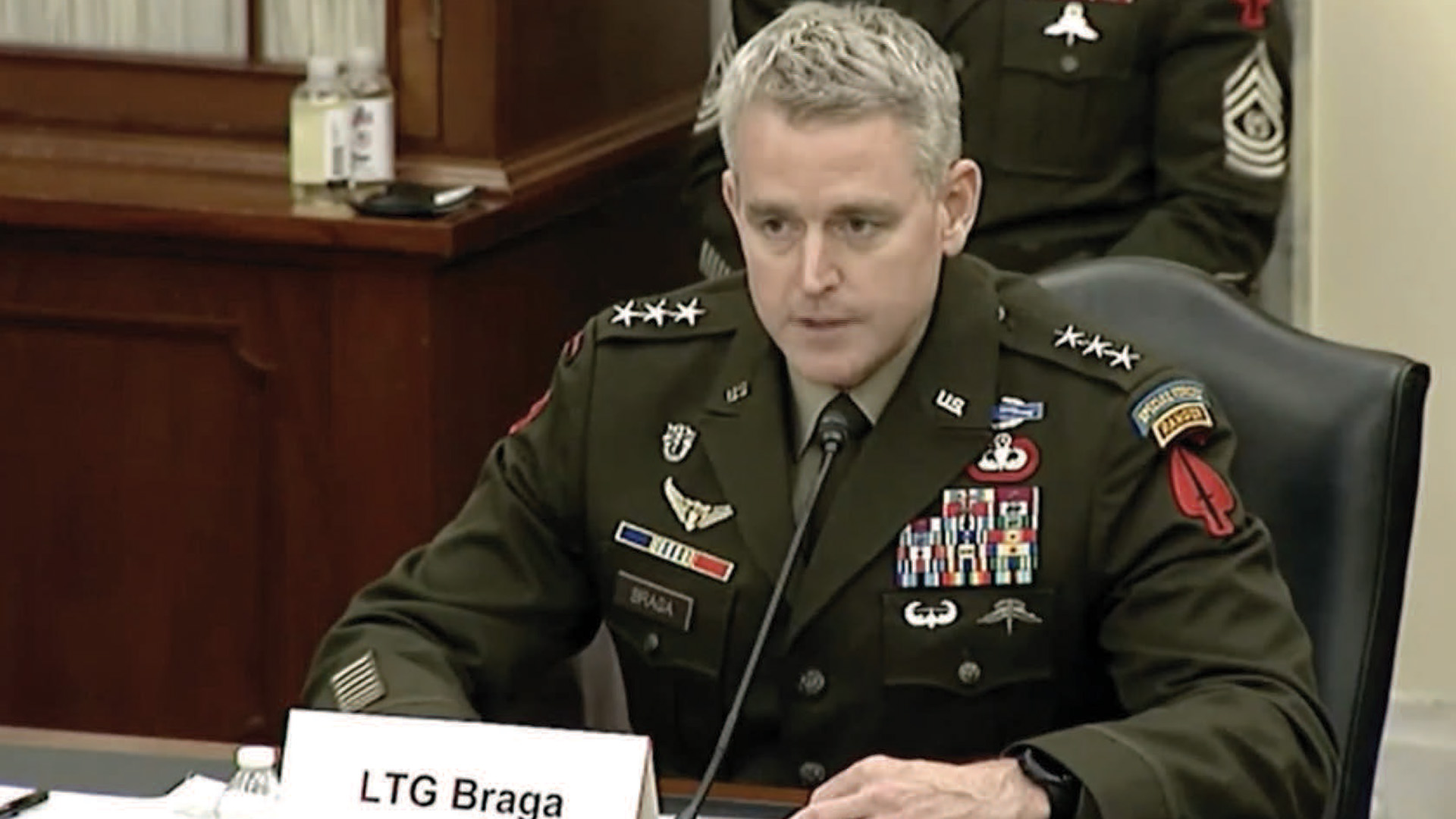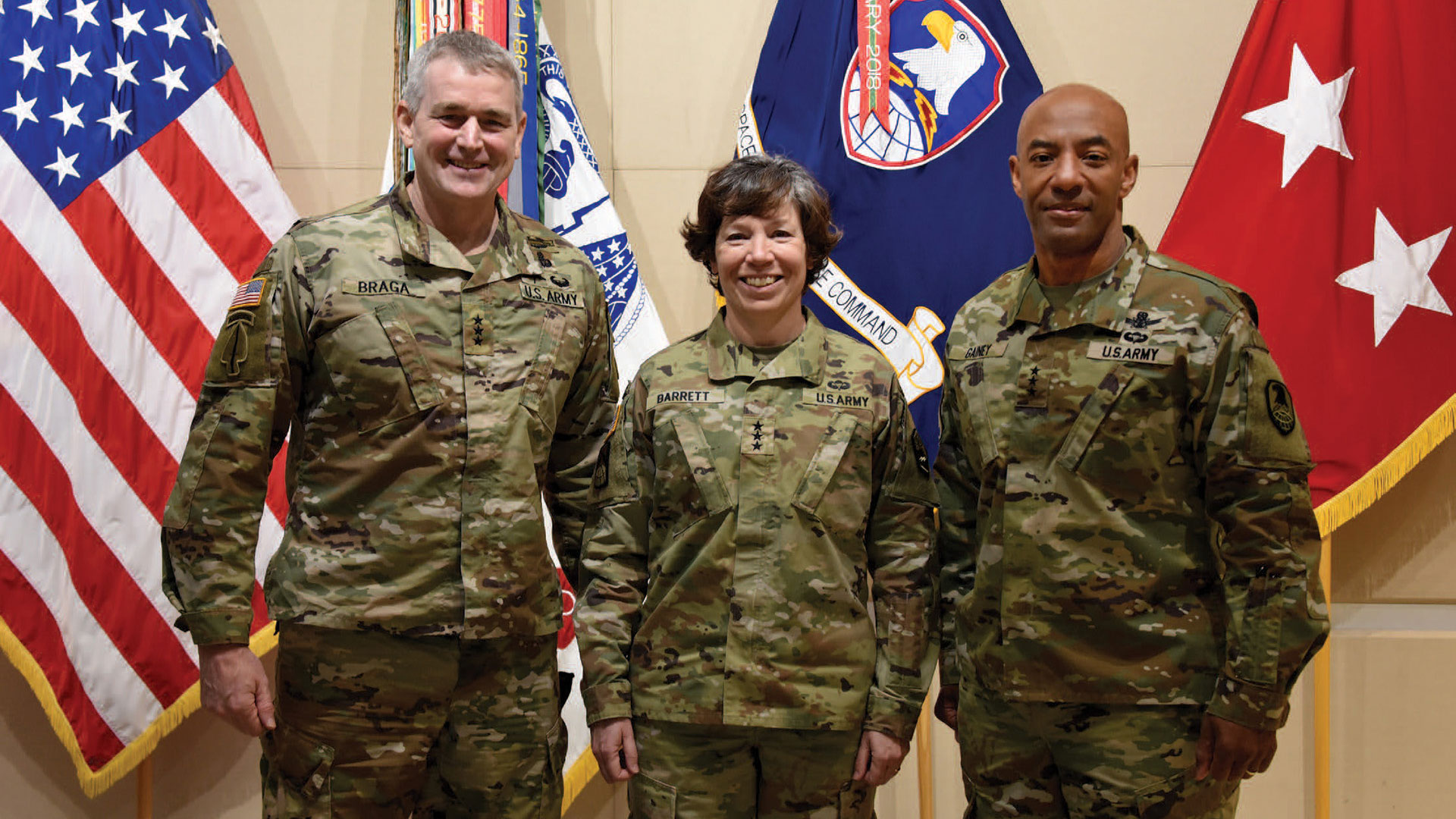SOF-Space-Cyber Triad
USASOC Commanding General talks TRIAD, dives into ARSOF strategy
Article published on: July 1st 2024, in the Summer-Fall 2024 Special Warfare Edition
Read Time: < 9 mins

Lt. Gen. Jonathan Braga Letter to The Senate Armed Services Committee: April 27, 2022
SPECIAL WARFARE JOURNAL - What is the SOF-Space-Cyber Triad? Why is this concept important to
“How ARSOF Fights?” As one of Lt. Gen. Jonathan Braga’s USASOC 2030 priorities, the Triad offers a solution:
“We are building a concept referred to as the SOF-Space-Cyber Triad. This is a convergence of transregional,
multi-domain, and joint capabilities to exponentially increase the holistic strategic effects of each capability
across the spectrum of conflict now and in the future. Our increasingly complex strategic landscape requires
innovative approaches that fuse and integrate all our expertise to maximize our collective impact.” 01
It may be helpful to open with what has already been articulated about the Triad by Lt. Gen. Braga and in some
publicly available documents from the United States Army Special Operations Command (USASOC).
These extracted dialogues and excerpts serve as a primer to help orient readers to the original intent and the
underlying thinking that supports the SOF-Space-Cyber Triad concept. When wrestling with what the Triad means
for the future of U.S. Army Special Operations, and the Joint Force, it is helpful to trace the concept’s
origins, where it is going, and how it is evolving. One of Lt. Gen. Braga’s first official articulations of what
the Triad is and why it is important emerged in a statement he gave to the Senate Armed Services Committee in
2022.

The U.S. Army’s top general for special operations, space, and cyber met to discuss the Triad
partnership at the third Triad 3-Star General Officer Steering Committee at USASMDC headquarters at Peterson
Space Force Base, Colorado, Jan. 31. Lt. Gen. Jonathon Braga, U.S. Army Special Operations Command; Lt. Gen.
Maria B. Barrett, U.S. Army Cyber Command; Lt. Gen. Sean A. Gainey, U.S. Army Space and Missile Defense Command,
discussed how they can further develop, operationalize, and institutionalize the collaboration.
Photo by Dottie
White, U.S. Army Space and Missile Defense Command Public Affairs Office.
The following year, USASOC began to build on the Triad concept by including it in the ARSOF Strategy 2030
document, integrating the Triad into other ARSOF initiatives. A few months later, Lt. Gen. Braga offered more
detail in on the Irregular Warfare Podcast, addressing how the concept does and does not relate to the nuclear
triad and a reaffirmation of how the concept continues to be a guiding organizational idea as ARSOF navigates an
increasingly complex operating environment.
How does the SOF-Space-Cyber Triad integrate with other USASOC initiatives? Why is there so little publicly available information about the triad? How is the triad being implemented across the ARSOF enterprise?
Lt. Gen. Braga’s testimony to Te U.S. Senate Committee on Armed Services, Wednesday, April 27, 2022, on efforts
to sustain special operations force readiness and transform the force for future security challenges.
“The seven modernization priorities for USASOC are: Irregular Warfare, Information Advantage, Multi-Domain
Operations Interoperability, Next Generation Precision Effects, Unmanned Systems-Robotics-Artificial
Intelligence, Next Generation Mobility, and Enhanced ARSOF Soldiers. We synchronize within these priorities
while remaining a bottom-up driven organization. We have men and women on the ground identifying problems and
providing requirements. Whether we lead or support, USASOC serves as a catalyst for innovation through our
continued experimentation and operational use. We are deliberate with our selective disclosure, knowing our
initiatives drive adversary decision cycles.
Last month, 44 organizations participated in a USASOC exercise focused on the intersection of SOF-Space-Cyber
Triad capabilities leading to a series of upcoming experiments. Lessons learned allow us to test our assumptions
and solutions in Service (Army Project Convergence 2022) and Joint Force exercises (Unified Pacific 2022).
Hardware solutions are important, but people remain our primary focus.” 02
Where does the SOF-Space-Cyber triad exist within USASOC's strategic lines of effort(LOE)? How does the triad support the wider joint force?
The United Stated Army Special Operations Command’s Army Special Operations Forces Strategy 2030, released April
6, 2023, describes the lines of effort, capabilities and resources, and roles and missions of the organization
as it looks to modernize and transform.
LINE OF EFFORT 1. Transform ARSOF–This approach allows USASOC to recognize new, or existing,
problems that current capabilities cannot adequately address. USASOC’s force modernization efforts are mutually
supporting the Army, and the Joint Force’s objectives in the employment of new technologies, operational
methods, and organizational approaches. USASOC will contribute to and at times lead Army and Joint Force
experimentation events. Activities associated with this effort include actions designed to identify future
requirements and develop solutions to future challenges through concepts, doctrine, organization, training,
materiel, leadership, personnel, facilities, and policy. Our triad partnership (SOF, Space, and Cyber) will
break down barriers to operating across these new and contested domains to deliver unique options. Development
of the triad conceptually, as well as experimentation, nests under this LOE, as do our modernization efforts in
next-generation precision strike, unmanned systems-robotics-AI, counter unmanned aerial systems, and contested
communications. 03
How do the components relate to one another and why is their relationship important to the current strategic environment?
In the 2030 Strategy, released April 6, 2023, it describes another line of effort of the organization as it looks
to modernize and transform.
The Space-Cyber-SOF Triad describes an interdependent and mutually supporting relationship between cyberspace,
space, and SOF. Special operations often rely upon the information advantage provided by cyberspace and space
capabilities to see, sense, and stimulate to influence relevant populations or strike deep into the physical
nodes of an adversary’s system and assess the results. Cyberspace operations may rely on SOF’s physical access
and placement to deliver effects. Cyberspace, space, and SOF are unique in their global reach, persistence,
endurance, and responsiveness. The cross-domain convergence of capabilities enables effects at all levels and
can be seamlessly integrated into irregular warfare campaigns. 04
Army Special Operations Forces Strategy 2030 vision and strategy describes how USASOC will
generate, posture, and transform our forces to realize this vision alongside our generational partners and
allies. Images provided by USASOC.
How is the SOF-Space-Cyber triad operationalized and where does it fit within policy maker response options to strategic problem sets? How does this triad compare to the traditional nuclear triad?
Irregular Warfare Podcast: May 2, 2023 Interview, hosted by Ben Jebb and Kyle Altwell, Modern Warfare Institute
at West Point as part of the Irregular Warfare Initiative.
BRAGA: “…everything in space or in cyber all has some type of terrestrial conduit that,
in a sense, is networked and, in a sense, is a vulnerability point for both friend and foe and is an
opportunity. So, SOF can absolutely be mutually supporting to our cyber and our space partners out there, but I
think combined [sic], that’s why I talk about the combined SOF-Space-Cyber Triad. It’s absolutely critical that
we develop this and bring capability both for high-end conflict but, I would argue, steady-state competition as
well. This is a modern-day triad; it doesn’t replace nuclear triad. It doesn’t replace strategic deterrence. But
it’s absolutely complimentary because it is used throughout the spectrum of conflict, and it provides
policymakers flexible deterrence and response options that are below the level of armed conflict.”
HOST: “So, something of note that I found especially interesting in the ARSOF strategy
was this term that you just used, the Space-Cyber-SOF Triad. I think most people’s images of SOF conjures decked
out operators, kicking in doors, conducting raids, things like that. But the Space-Cyber-SOF Triad talks a lot
more about the interplay being mutually supportive in the space domain, offering cyber capabilities, and it
seems like SOF might be well situated to address that. So, can you kind of flesh that concept out a little bit
and talk about how you define this concept and explain why SOF is particularly well suited to leverage and, I
guess, leverage and enhance cyber and space capabilities? Question for both of you, but I’ll direct that one to
Jon first.”
BRAGA: “Sure, and I’ll start with the word ‘concept’. I think it’s important when we
coalesced around that term triad, it did have connotations. You know, back in the day if you were my age or
older and you took any international relations degree, you knew about George Kennan and Tomas Schelling. And the
word ‘triad’ meant everything from the word capabilities from subs, silos, and bombers to deterrence theory and
game theory to international relations to the Cuban missile crisis to tactical nuclear weapons to artillery
delivered nuclear weapons, I mean it meant everything. From TTPs up to strategy up to policy. Tere wasn’t an
international relations degree-producing university that didn’t cover it.
I think that much thought needs
to go into this modern day triad, the SOF-Space-Cyber Triad there, because it is the newest tools out there that
can have strategic effect, or it can be a much lower effect depending on what is decided and what is employed
there. So, it’ important that there is a robust investment, in my opinion, from the academic community to the
policy community to the military community of, ‘what is the best way to employ these capabilities and
techniques,’ again, from strategy, theory, policy down to things and widgets and capabilities and equipment.
Ultimately, some of our tasks are the same. Whether it is employing the SOF-Space-Cyber Triad or other elements.
It’s to help our force, the joint force, see further, strike faster, and hopefully inhibit the adversary to do
the same and blind the adversary there a little bit and hopefully impose doubt, cost, and belief [sic] on
different ways there.”
Conclusion:
The SOF-Space-Cyber Triad is a concept that integrates trans-regional, multi-domain, and joint capabilities to
achieve strategic effects. This approach advocates for dismantling the artificial barriers between military
domains in response to the increasingly complex geopolitical landscape, evolving threats, and advancing
technologies. Such innovation is critical to developing capabilities to support military campaigns in
competition and conflict. It is important to note that the SOF-Space-Cyber Triad is neither intended to replace
nor replicate the historically established U.S. nuclear triad. Drawing from Lt. Gen. Braga’s forward-looking
perspective, this triad is an evolving model that addresses emerging challenges. It aims to inspire similarly
deep strategic thought and complement all US war-making and deterrence methods by introducing pioneering
strategies that leverage modern information technology—from the ground to orbital planes. Doing so provides the
joint force with enhanced tools and offers policymakers greater flexibility.